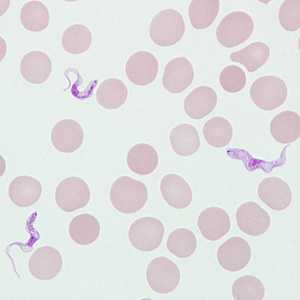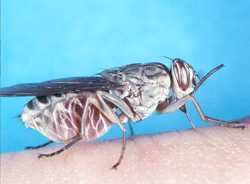Epidemiology & Risk Factors

Trypomastigotes of T. brucei ssp. in a blood smear stained with Giemsa. Credit: DPDx
There are two subspecies of the parasite Trypanosoma brucei that cause disease in humans. The clinical features of the infection depend on the subspecies involved. The two subspecies are found in different regions of Africa. At present, there is no overlap in their geographic distribution.
T. b. rhodesiense (East African sleeping sickness) is found in focal areas of eastern and southeastern Africa. Each year a few hundred cases are reported to the World Health Organization. Over 95% of the cases of human infection occur in Tanzania, Uganda, Malawi, and Zambia. Animals are the primary reservoir of infection. Cattle have been implicated in the spread of the disease to new areas and in local outbreaks. A wild animal reservoir is thought to be responsible for sporadic transmission to hunters and visitors to game parks. Infection of international travelers is rare, but it occasionally occurs. In the U.S., one case per year, on average, is diagnosed. Most cases of sleeping sickness imported into the U.S. have been in travelers who were on safari in East Africa.
T. b. gambiense (West African sleeping sickness) is found predominantly in central Africa and in limited areas of West Africa. Most of the sleeping sickness in Africa is caused by this form of the parasite. Epidemics of sleeping sickness have been a significant public health problem in the past, but the disease is reasonably well-controlled at present, with 7,000-10,000 cases reported annually in recent years. Over 95% of the cases of human infection are found in Democratic Republic of Congo, Angola, Sudan, Central African Republic, Chad, and northern Uganda. Humans are the important reservoir of infection, although the parasite can sometimes be found in domestic animals (e.g., pigs, dogs, goats). Imported infection in the U.S. is extremely rare, and most cases have occurred in African nationals who have immigrated rather than in returning U.S. travelers.

Close up of a tsetse fly taking a blood meal. Tsetse flies can transmit T. brucei.
Both forms of sleeping sickness are transmitted by the bite of the tsetse fly (Glossina species). Tsetse flies inhabit rural areas, living in the woodlands and thickets that dot the East African savannah. In central and West Africa, they live in the forests and vegetation along streams. Tsetse flies bite during daylight hours. Both male and female flies can transmit the infection, but even in areas where the disease is endemic, only a very small percentage of flies are infected. Although the vast majority of infections are transmitted by the tsetse fly, other modes of transmission are possible. Occasionally, a pregnant woman can pass the infection to her unborn baby. In theory, the infection can also be transmitted by blood transfusion or sexual contact, but such cases have rarely been documented.
This information is not meant to be used for self-diagnosis or as a substitute for consultation with a health care provider. If you have any questions about the parasites described above or think that you may have a parasitic infection, consult a health care provider.
- Page last reviewed: August 29, 2012
- Page last updated: August 29, 2012
- Content source:


 ShareCompartir
ShareCompartir